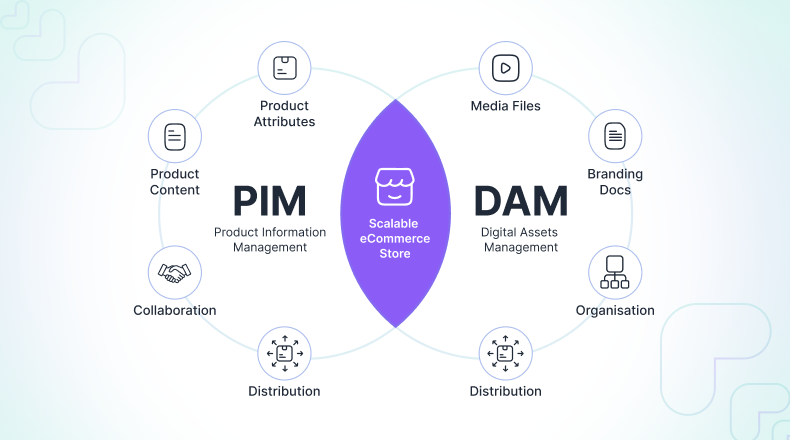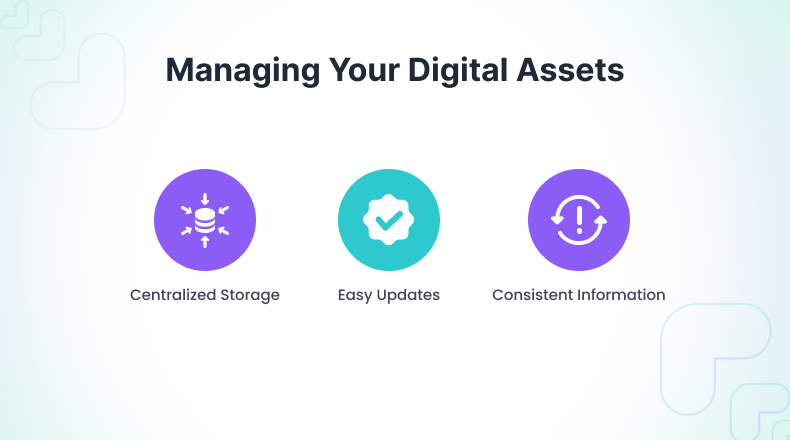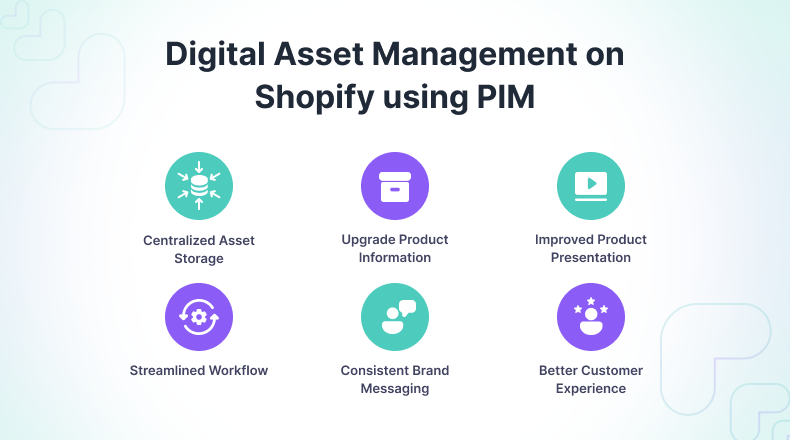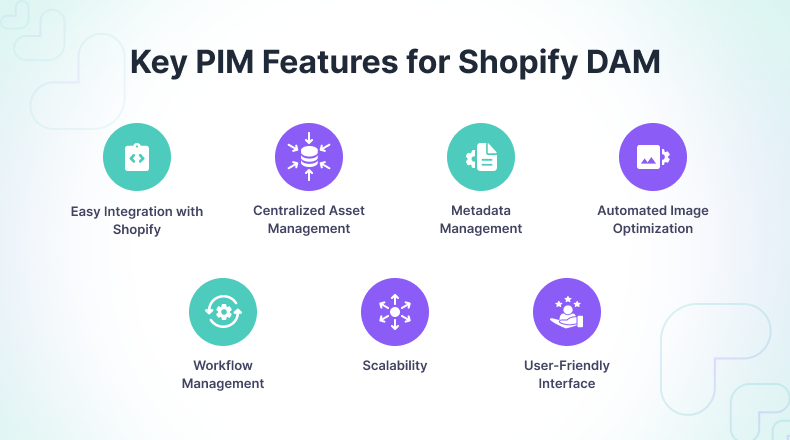Updated 30 May 2025
In this user guide, we will explore how to manage digital assets in Shopify using PIM.
Managing product images, videos, and detailed information in a Shopify store can quickly become overwhelming, especially as your catalog grows.
That’s where Digital Asset Management (DAM) and Product Information Management (PIM) systems come in.
These tools help store owners centralize, organize, and optimize their product content, ensuring accurate, consistent, and high-quality listings across all sales channels.
In this article, we’ll explore how Shopify merchants can use PIM and DAM solutions to improve workflow efficiency, boost product page quality, and ultimately drive more conversions.
Think of DAM as a special place to keep all your digital stuff. This includes photos, videos, and documents.
It helps you find what you need quickly. Also, it makes sure everyone uses the right versions of your files.
Product Information Management (PIM) is like a central hub for all your product details. This includes names, descriptions, and prices.
It makes sure all your product info is correct and consistent across all your sales channels.
For a brief overview of PIM, start with “What is PIM?“
If you use Shopify, DAM and PIM can make your life easier. They help you manage your product info and digital assets better. This can lead to happier customers and more sales.

DAM and PIM work best when they are used together. PIM manages the text and numbers. DAM manages the images and videos. Together, they make sure your product listings are top-notch.
Tips for Using DAM and PIM in Shopify
Here are some tips to get the most out of DAM and PIM:
Digital assets are very important for online stores. They help customers learn about your products. Also, they make your store look good. Let’s see why they matter and how to use them well.
Think of digital assets as the building blocks of your online store. These include product images, videos, and descriptions. Good assets show off your products and tell their story.
Types of Digital Assets
There are many types of digital assets. Each one plays a special role in e-commerce.
I. Product Images
Clear, attractive photos are a must. Show your products from different angles. Also, use images that highlight important features.
II. Product Videos
Videos can show products in action. They can also explain how to use them. This helps customers understand what they are buying.
III. Product Descriptions
Good descriptions tell customers everything they need to know. Include details about size, materials, and benefits. Make sure your descriptions are easy to read.
IV. Logos and Banners
Your logo represents your brand. Banners can promote special offers. Use them to create a consistent look and feel for your store.
Keeping your digital assets organized is very important. A PIM system can help. It keeps all your product information in one place.

Tips for Using Digital Assets Well
Here are some tips to make the most of your digital assets.
Examples of Great Digital Asset Use
Many companies use digital assets very well.
Challenges of Managing Digital Assets in Shopify Without a PIM
Imagine you’re running a store on Shopify.
You have many product photos, videos, and descriptions. Keeping everything organized can be hard. Without a special tool called a PIM, things can get messy.
Managing digital assets in Shopify can be tough without a PIM. A PIM is like a central hub for all your product information. Without it, you might face several challenges.
I. Keeping Things Consistent
It’s hard to keep product information the same everywhere. For example, the same product might have different descriptions. This can confuse customers.
II. Taking Up Too Much Time
Updating product information takes a lot of time. You have to change things in many places. This could be your Shopify store, ads, and other sales channels.
III. Making Mistakes
When you update information by hand, mistakes can happen. You might type the wrong price or description. These mistakes can cost you money.
IV. Trouble Scaling Up
As your business grows, managing assets gets even harder. More products mean more photos and descriptions. Without a PIM, it’s hard to keep up.
Real-World Example
Think about a clothing store. They sell shirts, pants, and jackets. Each item has many photos and sizes.
Without a PIM, updating the price of every shirt on the website takes hours. There is also a risk of making mistakes.
With a PIM, they can change the price once. After that, it updates everywhere automatically.
Imagine you have a lot of toys. Now, think about keeping them organized.
A PIM system helps you do that with your online store’s pictures and information. It makes managing your Shopify store much easier.

A PIM system acts like a central hub. It keeps all your product pictures and details in one place. Therefore, you don’t have to search everywhere for them. This saves you time and prevents mistakes.
For example, imagine you sell t-shirts. With a PIM, all t-shirt photos, descriptions, and sizes are in one spot. So, updating information becomes super easy.
With a PIM, your product information is always correct. It ensures your customers see the right details. Therefore, this builds trust and can increase sales.
In addition, a PIM system helps you add extra information. You can include details like materials, care instructions, and more. This helps customers make better choices.
Good pictures and descriptions make your products look great. A PIM system helps you manage these easily. As a result, your products look more appealing to customers.
For example, you can quickly update product images for a sale. Also, you can add videos to show how a product works. This makes your store more engaging.
A PIM system makes your work faster and easier. It helps you update product information quickly. Therefore, you can focus on other important tasks.
Furthermore, a PIM system can automate tasks. For example, it can resize images or update prices automatically. This saves you a lot of time.
A PIM system ensures your brand message is the same everywhere. It helps you keep your product information consistent. Therefore, customers see a clear and reliable brand.
In addition, you can use a PIM to manage different versions of your product descriptions. This is useful if you sell in different countries.
When customers have all the information they need, they are happier. A PIM system helps you provide that information. As a result, customers have a better shopping experience.
For example, clear product descriptions reduce confusion. High-quality images help customers see what they are buying. This leads to more sales and happier customers.
Choosing the right Product Information Management (PIM) system is super important.Especially effective with PIM for Shopify asset management.
A good PIM helps you keep all your product info and images organized. It also makes sure your online store looks its best. So, what should you look for in a PIM? Let’s find out!

First, make sure the PIM system works well with Shopify.
For example, imagine you update a product description in your PIM. With good integration, that new description will show up on your Shopify store automatically.
A PIM should be like a central hub for all your digital assets.
Think of it like a digital library for your products. Everything is neatly organized and easy to find.
Metadata is like extra information about your images and files.
For instance, you can tag an image with keywords like “red dress,” “summer collection,” and “cotton fabric.” This makes it easier to find and helps customers find your products online.
Images need to be just the right size and format for your website.
Imagine you have a high-resolution image. The PIM can automatically create smaller versions for your product pages and thumbnails.
A good PIM helps you manage the process of creating and updating product information.
For example, you can assign the task of writing product descriptions to one person. Then, another person can approve those descriptions before they are published.
As your business grows, your PIM system needs to grow with you.
Therefore, choose a PIM that can handle your current needs and future growth.
Finally, the PIM system should be easy to use.
A user-friendly PIM will save you time and frustration. It will also make it easier for your team to use the system effectively.
Choosing the right PIM for your Shopify store is a big decision. Keep these key features in mind to find a system that meets your needs.
With a good PIM, you can manage your digital assets effectively and boost your online sales. So, start exploring your options today and take your Shopify store to the next level!
Do you have a Shopify store? Do you want to make it even better? Then, think about using a Product Information Management (PIM) system.
It can help you manage all your product details in one place. This makes your online store easier to use and more successful.
Imagine you have lots of products in your Shopify store. Each product has many details. For example, names, descriptions, sizes, colors, and pictures.
Keeping all this information organized can be hard. That’s where a PIM system comes in.
A PIM system helps you keep all your product information in one central place.
Therefore, it’s easier to update and share this information with your Shopify store. This means your customers always see the correct details.
How to Integrate PIM with Shopify
Integrating a PIM system with your Shopify store might sound tricky. However, it’s simpler than you think. Here are the general steps:
I. Choose a PIM System: First, find a PIM system that works well with Shopify. Some popular choices include Plytix, Akeneo, and Pimberly.
II. Connect the Systems: Next, connect your PIM system to your Shopify store. Most PIM systems have apps or tools that make this easy.
III. Import Your Data: After that, move all your product information from Shopify to the PIM system. This might take some time, but it’s worth it.
IV. Manage Your Products: Then, use the PIM system to update and manage your product details. When you make changes in the PIM, they will automatically appear in your Shopify store.
Do you have lots of pictures and details for your products? Keeping them organized in Shopify can be hard.
A Product Information Management (PIM) system can help! It makes managing all your digital assets easier. Let’s learn how to use a PIM with Shopify step by step.
First, you need to connect your Shopify store to the PIM system. Most PIMs have apps or tools to help with this.
Connecting them makes it easy to move product info between Shopify and the PIM.
Next, bring all your product info from Shopify into the PIM. This includes pictures, descriptions, and prices.
This step puts all your product information in one place.
Now, it’s time to organize your pictures and other files in the PIM. Good organization helps you find things faster.
For example, create a folder for “Summer Dresses.” Then, tag each picture with colors like “blue” or “red.”
With all your data in the PIM, you can make it better. This helps customers find what they need and buy more.
Good product information helps customers trust your store.
After improving your product info, send it back to Shopify. This keeps your store up-to-date.
Keeping your Shopify store updated with the PIM ensures customers see the latest information.
Managing digital assets is ongoing. Keep your PIM updated with new products and information.
Regular updates keep your product information accurate and helpful.
Make sure your team knows how to use the PIM. Training helps everyone manage digital assets the right way.
A well-trained team can make the most of your PIM system.
Using a PIM with Shopify can seem tricky at first. However, following these steps makes it easier. You’ll keep your product information organized.
Also, you’ll improve your customer’s shopping experience.
Ready to take control of your digital assets? Start by connecting your Shopify store to a PIM today!
Having great pictures and videos is key to selling things online. However, keeping all those files organized can be hard.
That’s where using a Product Information Management (PIM) system with Shopify comes in handy.
Let’s explore how to manage your digital assets well.
Think of your website as a store. The better it looks, the more people want to shop there. Good digital asset management (DAM) helps you show off your products in the best way.
It also makes sure your website runs smoothly.
Here are some simple ways to manage your digital assets in Shopify using a PIM:
* Keep all your pictures, videos, and documents in one place. A PIM system can be that place. Therefore, it’s easier to find and use them.
* For example, instead of having files scattered across different computers, put them all in your PIM.
* Give your files names that make sense. For example, instead of “IMG123.jpg,” use “red-t-shirt-front.jpg.”
* Also, be consistent with how you name files. This helps everyone on your team find what they need.
* Use tags to describe your files. For example, tag a picture of a blue dress with “dress,” “blue,” and “summer.”
* Furthermore, tags make it easier to search for files in your PIM system.
* Make sure your pictures are the right size for your website. Big pictures can slow down your site.
* Therefore, use tools to make your images smaller without losing quality.
* Decide who can see and use your files. A PIM system lets you set permissions.
* For example, you might want only certain people to be able to change important images.
* Regularly check your files to make sure they are still correct. Remove old or outdated images.
* In addition, this keeps your website looking fresh and accurate.
The world of online shopping is always changing. To stay ahead, businesses need to know what’s coming next.
Digital Asset Management (DAM) and Product Information Management (PIM) are becoming more important than ever. Let’s explore some future trends in these areas.
Artificial intelligence (AI) is changing how we do things. It’s also making DAM and PIM systems smarter. AI can help you automatically tag images.
Also, it can suggest product descriptions. This saves time and makes your work easier.
For example, imagine you have many product photos. AI can analyze these photos. Then, it can add relevant tags.
This makes it easier for customers to find what they need. Furthermore, AI can help keep your product information up-to-date.
Customers want a shopping experience that feels personal. DAM and PIM can help with this. These systems can store information about your customers.
Then, you can use this information to show them products they might like.
For instance, a clothing store can use DAM and PIM. They can show different products to different customers. A customer who often buys blue shirts might see more blue shirts.
This makes the shopping experience more personal. Therefore, it increases the chances of a sale.
More people are shopping on their phones. So, your DAM and PIM systems need to work well on mobile devices. This means having images and product information that look good on smaller screens.
Think about a customer browsing on their phone. They should be able to see clear images. Also, they should be able to read product descriptions easily.
A mobile-first approach ensures a good experience for these customers. In addition, it can lead to more sales.
Teams need to work together to manage digital assets and product information. Future DAM and PIM systems will make this easier. They will offer better tools for sharing and collaborating on content.
For example, imagine a team working on a new product launch. They can use a DAM system to share images and videos. Also, they can use a PIM system to update product descriptions.
Enhanced collaboration ensures everyone is on the same page. Therefore, it leads to a smoother launch.
Customers care more about sustainability. They want to know that the products they buy are made ethically. DAM and PIM systems can help you share this information.
You can use them to store and display information about your products’ environmental impact.
For instance, a food company can use a PIM system. They can share information about where their ingredients come from. Also, they can share information about their sustainable practices.
This can attract customers who care about the environment. Furthermore, it can build trust in your brand.
This article discusses how Shopify merchants can simplify content and product data management with DAM and PIM systems, and improve digital asset management in Shopify using PIM.
DAM provides centralized storage for images and videos, while PIM serves as a hub for product details like descriptions and prices.
Together, these systems help merchants maintain consistent information across sales channels, improve workflow efficiency, enhance product presentations, and deliver better customer experiences.
The article covers key benefits, implementation steps, essential features to look for in these systems, and emerging trends in e-commerce asset management.

If you have more details or questions, you can reply to the received confirmation email.
Back to Home
Be the first to comment.